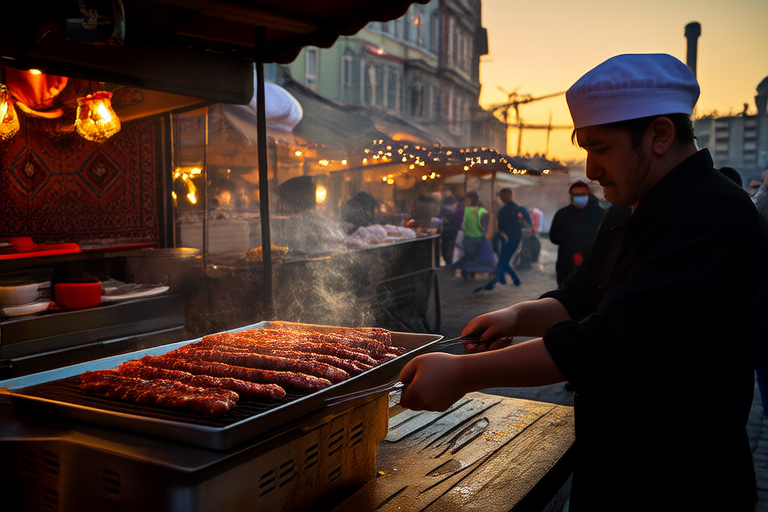Global Flavors in Every Step: Combining Wanderlust with Epicureanism

Global Flavors in Every Step: Combining Wanderlust with Epicureanism
Introduction
The world is a vast tapestry woven with threads of culture, history, and tradition, each strand contributing to its vibrant complexity. At the heart of this intricate design lies the universal language of food. Travel, often referred to as ‘wanderlust,’ is the act of exploring new horizons, meeting different people, and discovering new landscapes. Meanwhile, ‘epicureanism’ encapsulates the pursuit of refined and delightful sensory experiences, particularly those involving taste. When combined, these two passions create an unparalleled journey that enriches both the palate and the soul.
Experiencing local cuisine is not just about satisfying hunger; it’s about immersing oneself in the heart of a place. Each dish tells a story, reflecting the geography, climate, history, and social fabric of its origin. Whether it’s the spicy curries of India, the delicate sushi of Japan, or the hearty stews of Eastern Europe, every bite offers insight into the lives of those who prepare and consume them. This deep connection between food and culture makes culinary exploration an integral part of any meaningful travel experience.
In this article, we will delve into the rich diversity of global flavors, exploring how food serves as a bridge between cultures and how travelers can best engage with local cuisines. From iconic dishes to evolving food traditions, we will uncover the essence of culinary tourism and discuss ways to approach it responsibly. Let us embark on this gastronomic adventure together, where every step brings us closer to understanding the world through its most beloved medium—food.
The Role of Food in Cultural Exploration
Food is more than sustenance; it is a window into the soul of a culture. Every meal prepared and shared carries with it stories of heritage, survival, and celebration. For instance, in Mexico, tacos are far more than just street food—they represent centuries-old traditions passed down through generations. Each bite of a perfectly grilled carne asada taco wrapped in soft corn tortillas transports you back to the bustling markets of colonial towns where indigenous and Spanish influences merged.
Similarly, the humble pho of Vietnam encapsulates the country’s resilience and adaptability. Originating during French colonization, this fragrant broth made from beef bones, star anise, and cinnamon has become synonymous with Vietnamese identity. It symbolizes the blending of Eastern and Western culinary techniques, creating something uniquely Vietnamese. By tasting pho, one gains insight into the historical context of Vietnam’s development.
As cultures interact and evolve, so too do their food traditions. Today, many cities boast fusion cuisines that blend elements from multiple countries, reflecting globalization and migration patterns. In London, for example, one can find everything from Japanese ramen shops serving British-style bangers and mash alongside traditional miso soup to Indian restaurants offering curry dishes inspired by Caribbean spices. These culinary fusions illustrate how food evolves organically within communities, adapting to changing tastes and circumstances.
Tasting the World Through Travel
For those eager to dive deeper into the world of culinary travel, certain destinations stand out as ideal spots for immersive food adventures. Italy, with its abundance of regional specialties like Neapolitan pizza, Sicilian cannoli, and Piedmontese truffles, offers an unparalleled opportunity to explore diverse Italian cuisine. Japan, known for its precision and artistry in cooking, invites visitors to experience everything from high-end kaiseki dining to casual izakaya bars serving sake and yakitori.
To truly savor authentic flavors, it’s crucial to seek out local eateries rather than relying solely on tourist traps. Markets are excellent starting points, offering fresh produce, artisanal products, and direct interaction with vendors who can provide invaluable recommendations. In Thailand, the Chatuchak Weekend Market in Bangkok provides access to an array of street foods, from crispy fried insects to aromatic pad thai noodles. Similarly, the Central Market in Singapore showcases Southeast Asian delicacies under one roof.
Engaging with locals is another effective way to gain deeper knowledge about a region’s culinary landscape. Many communities offer cooking classes or guided tours led by passionate chefs and home cooks willing to share their expertise. In Morocco, joining a cooking workshop allows participants to learn traditional techniques used in preparing tagines and pastilla while gaining insights into Berber customs. Such hands-on experiences foster genuine connections and leave lasting impressions.
Sustainable Culinary Tourism
As interest in culinary tourism grows, so does the need for responsible practices that ensure sustainability and respect for host communities. Supporting small, family-owned businesses instead of large chains helps preserve local economies and maintains cultural integrity. Additionally, choosing establishments that prioritize locally sourced ingredients reduces carbon footprints associated with long-distance transportation.
Ethical considerations extend beyond economic impacts; they also involve environmental stewardship. Sustainable agriculture practices, such as organic farming and water conservation, contribute positively to ecosystems. By patronizing restaurants committed to these principles, tourists help promote healthier environments for future generations.
Ultimately, embracing sustainable culinary tourism means approaching each destination with mindfulness and appreciation. It involves recognizing the value of cultural exchange and being conscious consumers who support initiatives that enhance rather than exploit local resources.
Conclusion
Throughout this exploration of combining wanderlust with epicureanism, we have seen how food transcends mere nourishment to become a powerful tool for cultural understanding and personal growth. From iconic dishes to evolving food traditions, every bite offers a glimpse into the lives and histories of those who prepare and enjoy them.
The transformative power of culinary travel lies in its ability to connect people across borders and foster mutual respect. As we continue to explore new lands and flavors, let us do so with curiosity, openness, and a commitment to responsible practices that benefit both the environment and the communities we visit.
We hope this journey has inspired you to embark on your own culinary adventures, armed with a deeper appreciation for the diverse global flavors that await. Bon appétit!